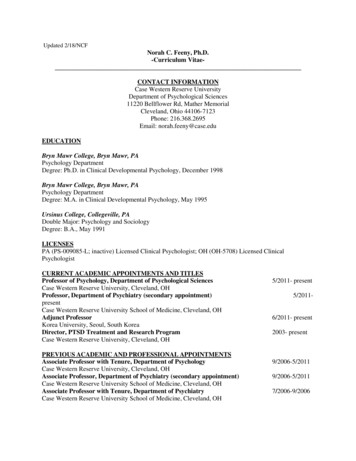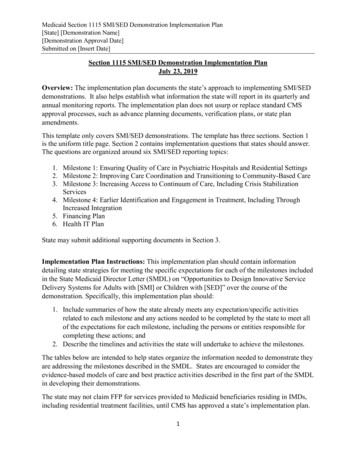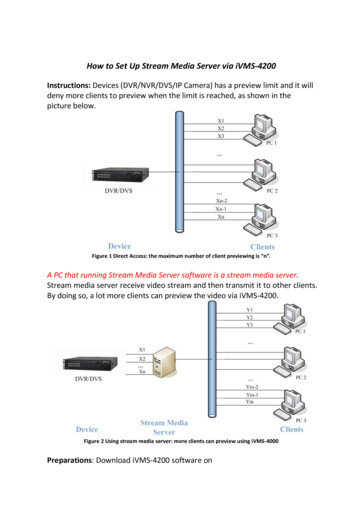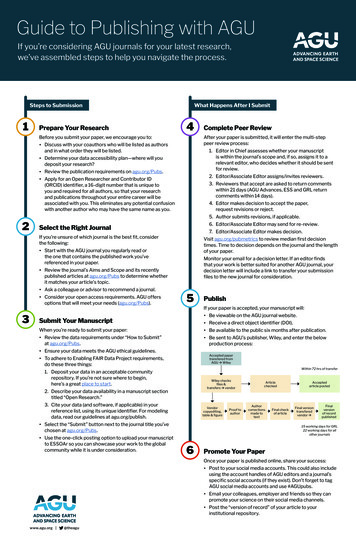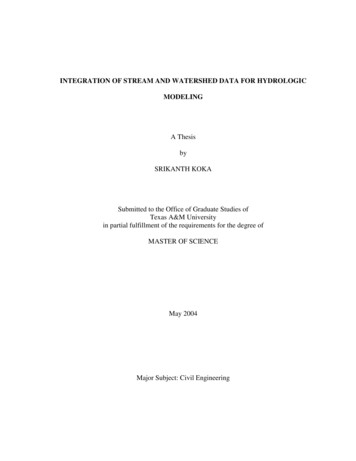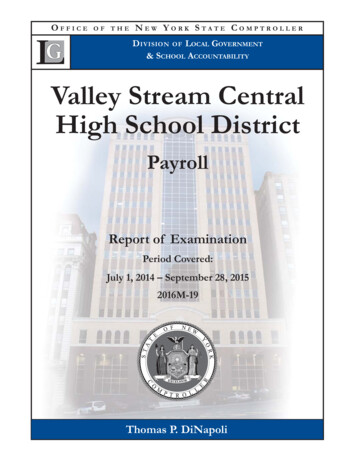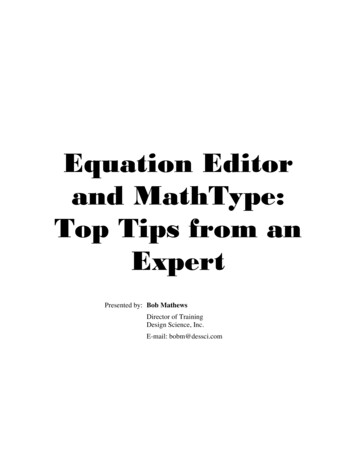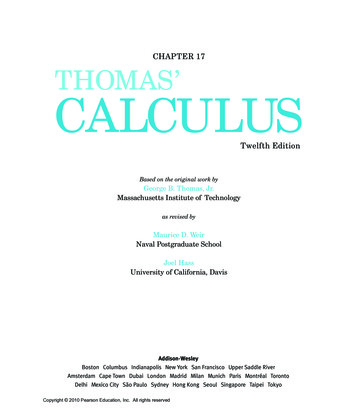
Transcription
Stream Editori
Stream EditorAbout the TutorialThis tutorial takes you through all about Stream EDitor (SED), one of the mostprominent text-processing utilities on GNU/Linux. Similar to many other GNU/Linuxutilities, it is stream-oriented and uses simple programming language. It is capable ofsolving complex text processing tasks with few lines of code. This easy, yet powerfulutility makes GNU/Linux more interesting.AudienceIf you are a software developer, system administrator, or a GNU/Linux loving person,then this tutorial is for you.PrerequisitesYou must have basic understanding of GNU/Linux operating system and shell scripting.Copyright & Disclaimer Copyright 2014 by Tutorials Point (I) Pvt. Ltd.All the content and graphics published in this e-book are the property of Tutorials Point(I) Pvt. Ltd. The user of this e-book is prohibited to reuse, retain, copy, distribute orrepublish any contents or a part of contents of this e-book in any manner without writtenconsent of the publisher.We strive to update the contents of our website and tutorials as timely and as preciselyas possible, however, the contents may contain inaccuracies or errors. Tutorials Point (I)Pvt. Ltd. provides no guarantee regarding the accuracy, timeliness or completeness ofour website or its contents including this tutorial. If you discover any errors on ourwebsite or in this tutorial, please notify us at contact@tutorialspoint.comi
Stream EditorTable of ContentsAbout the Tutorial .iAudience .iPrerequisites .iCopyright & Disclaimer .iTable of Contents .ii1.SED OVERVIEW . 1Typical Uses of SED .12.SED ENVIRONMENT . 2Installation Using Package Manager .2Installation from Source Code .33.SED WORKFLOW. 54.SED BASIC SYNTAX . 7Standard Options .8GNU Specific Options .95.SED LOOPS. 106.SED BRANCHES . 127.SED PATTERN BUFFER. 148.SED PATTERN RANGE. 189.SED BASIC COMMANDS . 20Delete Command .20Write Command .21Append Command .23Change Command .25ii
Stream EditorInsert Command.26Translate Command .27l command .28Quit Command .29Read Command .30Execute Command .32Miscellaneous Commands .3410. SED SPECIAL CHARACTERS . 37 Command .37& Command .3911. SED STRINGS . 40Substitute Command.40Creating a Substring .43String Replacement Flags (GNU SED only) .4412. SED MANAGING PATTERNS . 4613. SED REGULAR EXPRESSIONS . 51Standard Regular Expressions .51POSIX Classes of Regular Expressions .57Metacharacters .5814. SED USEFUL RECIPES . 61Cat Command.61Removing Empty Lines .61Removing Commented Lines from a C Program .62Adding Comments Before Certain Lines .63Wc -l command .63Head Command.63iii
Stream EditorTail -1 Command .64Dos2unix Command .64Unix2dos command .65Cat -E command .66Cat -ET Command .66nl Command .67cp Command .67Expand Command .67Tee Command .68cat -s Command .68grep Command.69grep -v Command .69tr Command .70iv
1. SED OverviewStream EditorThe acronym SED stands for Stream EDitor. It is a simple yet powerful utility thatparses the text and transforms it seamlessly. SED was developed during 1973–74 by LeeE. McMahon of Bell Labs. Today, it runs on all major operating systems.McMahon wrote a general-purpose line-oriented editor, which eventually became SED.SED borrowed syntax and many useful features from ed editor. Since its beginning, ithas support for regular expressions. SED accepts inputs from files as well as pipes.Additionally, it can also accept inputs from standard input streams.SED is written and maintained by the Free Software Foundation (FSF) and it isdistributed by GNU/Linux. Hence it is often referred to as GNU SED. To a novice user,the syntax of SED may look cryptic. However, once you get familiar with its syntax, youcan solve many complex tasks with a few lines of SED script. This is the beauty of SED.Typical Uses of SEDSED can be used in many different ways, such as: Text substitution, Selective printing of text files, In-a-place editing of text files, Non-interactive editing of text files, and many more.1
2. SED EnvironmentStream EditorThis chapter describes how to set up the SED environment on your GNU/Linux system.Installation Using Package ManagerGenerally, SED is available by default on most GNU/Linux distributions. Use whichcommand to identify whether it is present on your system or not. If not, then install SEDon Debian based GNU/Linux using apt package manager as follows:[jerry] sudo apt-get install sedAfter installation, ensure that SED is accessible via command line.[jerry] sed --versionOn executing the above code, you get the following result:sed (GNU sed) 4.2.2Copyright (C) 2012 Free Software Foundation, Inc.License GPLv3 : GNU GPL version 3 or later http://gnu.org/licenses/gpl.html .This is free software: you are free to change and redistribute it.There is NO WARRANTY, to the extent permitted by law.Written by Jay Fenlason, Tom Lord, Ken Pizzini,and Paolo Bonzini.GNU sed home page: http://www.gnu.org/software/sed/ .General help using GNU software: http://www.gnu.org/gethelp/ .E-mail bug reports to: bug-sed@gnu.org .Be sure to include the word "sed" somewhere in the "Subject:" field.Similarly, to install SED on RPM based GNU/Linux, use yum package manager asfollows:[root]# yum -y install sedAfter installation, ensure that SED is accessible via command line.[root]# sed --versionOn executing the above code, you get the following result:GNU sed version 4.2.12
Stream EditorCopyright (C) 2009 Free Software Foundation, Inc.This is free software; see the source for copying conditions.There is NOwarranty; not even for MERCHANTABILITY or FITNESS FOR A PARTICULAR PURPOSE,to the extent permitted by law.GNU sed home page: http://www.gnu.org/software/sed/ .General help using GNU software: http://www.gnu.org/gethelp/ .E-mail bug reports to: bug-gnu-utils@gnu.org .Be sure to include the word "sed" somewhere in the "Subject:" field.Installation from Source CodeAs GNU SED is a part of the GNU project, its source code is available for free download.We have already seen how to install SED using package manager. Let us nowunderstand how to install SED from its source code.The following installation is applicable to any GNU/Linux software, and for most otherfreely-available programs as well. Here are the installation steps: Download the source code fromutilitywget serves this purpose.anauthentic place. Thecommand-line[jerry] wget ftp://ftp.gnu.org/gnu/sed/sed-4.2.2.tar.bz2 Decompress and extract the downloaded source code.[jerry] tar xvf sed-4.2.2.tar.bz2 Change into the directory and run configure.[jerry] ./configure Upon successful completion, the configure generates Makefile. To compile thesource code, issue a make command.[jerry] make You can run the test suite to ensure the build is clean. This is an optional step.[jerry] make check Finally, install the SED utility. Make sure you have superuser privileges.[jerry] sudo make installThat is it! You have successfully compiled and installed SED. Verify it by executingthe sedcommand as follows:3
Stream Editor[jerry] sed --versionOn executing the above code, you get the following result:sed (GNU sed) 4.2.2Copyright (C) 2012 Free Software Foundation, Inc.License GPLv3 : GNU GPL version 3 or later http://gnu.org/licenses/gpl.html .This is free software: you are free to change and redistribute it.There is NO WARRANTY, to the extent permitted by law.Written by Jay Fenlason, Tom Lord, Ken Pizzini,and Paolo Bonzini.GNU sed home page: http://www.gnu.org/software/sed/ .General help using GNU software: http://www.gnu.org/gethelp/ .E-mail bug reports to: bug-sed@gnu.org .Be sure to include the word "sed" somewhere in the "Subject:" field.4
3. SED WorkflowStream EditorIn this chapter, we will explore how SED exactly works. To become an expert SED user,one needs to know its internals. SED follows a simple workflow: Read, Execute, andDisplay. The following diagram depicts the workflow. Read: SED reads a line from the input stream (file, pipe, or stdin) and stores it inits internal buffer called pattern buffer. Execute: All SED commands are applied sequentially on the pattern buffer. Bydefault, SED commands are applied on all lines (globally) unless line addressing isspecified. Display: Send the (modified) contents to the output stream. After sending thedata, the pattern buffer will be empty. The above process repeats until the file is exhausted.Points to Note Pattern buffer is a private, in-memory, volatile storage area used by the SED. By default, all SED commands are applied on the pattern buffer, hence the inputfile remains unchanged. GNU SED provides a way to modify the input file in-aplace. We will explore about it in later sections. There is another memory area called hold buffer which is also private, inmemory, volatile storage area. Data can be stored in a hold buffer for laterretrieval. At the end of each cycle, SED removes the contents of the patternbuffer but the contents of the hold buffer remains persistent between SED cycles.However SED commands cannot be directly executed on hold buffer, hence SEDallows data movement between the hold buffer and the pattern buffer. Initially both pattern and hold buffers are empty.5
Stream Editor If no input files are provided, then SED accepts input from the standard inputstream (stdin). If address range is not provided by default, then SED operates on each line.ExamplesLet us create a text file quote.txt to contain a quote of the famous author Paulo Coelho.[jerry] vi quote.txtThere is only one thing that makes a dream impossible to achieve: the fear offailure.- Paulo Coelho, The AlchemistTo understand the workflow of SED, let us display the contents of the file quote.txt usingSED. This example simulates the cat command.[jerry] sed '' quote.txtWhen the above code is executed, it will produce the following result.There is only one thing that makes a dream impossible to achieve: the fear offailure.In the above example, quote.txt is the input file name and before that there is a pair ofsingle quote that implies the SED command. Let us demystify this operation.First SED reads a line from the input file quote.txt and stores it in its pattern buffer.Then it applies SED commands on the pattern buffer. In our case, no SED commands arethere, hence no operation is performed on the pattern buffer. Finally it deletes and printsthe contents of the pattern buffer on the standard output. Isn't it simple?In the following example, SED accepts input from the standard input stream.[jerry] sed '' press enter When the above code is executed, it will produce the following result.There is only one thing that makes a dream impossible to achieve: the fear offailure.There is only one thing that makes a dream impossible to achieve: the fear offailure.Here, the first line is entered through keyboard and the second is the output generatedby SED. To exit from the SED session, press ctrl-D ( D).6
4. SED Basic SyntaxStream EditorThis chapter introduces the basic commands that SED supports and their command-linesyntax. SED can be invoked in the following two forms:sed [-n] [-e] 'command(s)' filessed [-n] -f scriptfile filesThe first form allows to specify the commands in-line and they are enclosed within singlequotes. The later allows to specify a script file that contains SED commands. However,we can use both forms together multiple times. SED provides various command-lineoptions to control its behavior.Let us see how we can specify multiple SED commands. SED providesthe delete command to delete certain lines. Let us delete the 1st, 2nd, and 5th lines. Forthe time being, ignore all the details of the delete command. We will discuss more aboutthe delete command later.First, display the file contents using the cat command.[jerry] cat books.txtOn executing the above code, you get the following result:1) A Storm of Swords, George R. R. Martin, 12162) The Two Towers, J. R. R. Tolkien, 3523) The Alchemist, Paulo Coelho, 1974) The Fellowship of the Ring, J. R. R. Tolkien, 4325) The Pilgrimage, Paulo Coelho, 2886) A Game of Thrones, George R. R. Martin, 864Now instruct SED to remove only certain lines. Here, to delete three lines, we havespecified three separate commands with -e option.[jerry] sed -e '1d' -e '2d' -e '5d' books.txtOn executing the above code, you get the following result:3) The Alchemist, Paulo Coelho, 1974) The Fellowship of the Ring, J. R. R. Tolkien, 4326) A Game of Thrones, George R. R. Martin, 864Additionally, we can write multiple SED commands in a text file and provide the text fileas an argument to SED. SED can apply each command on the pattern buffer. Thefollowing example illustrates the second form of SED.7
Stream EditorFirst, create a text file containing SED commands. For easy understanding, let us use thesame SED commands.[jerry] echo -e "1d\n2d\n5d" commands.txt[jerry] cat commands.txtOn executing the above code, you get the following result:1d2d5dNow instruct the SED to read commands from the text file. Here, we achieve the sameresult as shown in the above example.[jerry] sed -f commands.txt books.txtOn executing the above code, you get the following result:3) The Alchemist, Paulo Coelho, 1974) The Fellowship of the Ring, J. R. R. Tolkien, 4326) A Game of Thrones,George R. R. Martin, 864Standard OptionsSED supports the following standard options: -n: Default printing of pattern buffer. For example, the following SED commanddoes not show any output:[jerry] sed -n '' quote.txt -e cmd : Next argument is an editing command. Here, angular brackets implymandatory parameter. By using this option, we can specify multiple commands.Let us print each line twice:[jerry] sed -e '' -e 'p' quote.txtOn executing the above code, you get the following result:There is only one thing that makes a dream impossible to achieve: thefear of failure.There is only one thing that makes a dream impossible to achieve: thefear of failure.- Paulo Coelho, The Alchemist- Paulo Coelho, The Alchemist8
Stream Editor -f filename : Next argument is a file containing editing commands. Theangular brackets imply mandatory parameter. In the following example, wespecify print command through file:[jerry] echo "p" commands[jerry] sed -n -f commands quote.txtOn executing the above code, you get the following result:There is only one thing that makes a dream impossible to achieve: thefear of failure.- Paulo Coelho, The AlchemistGNU Specific OptionsLet us quickly go through the GNU specific SED options. Note that these options are GNUspecific; and may not be supported by other variants of the SED. In later sections, wewill discuss these options in more details. -n, --quiet, --silent: Same as standard -n option. -e script, --expression script: Same as standard -e option. -f script-file, --file script-file: Same as standard -f option. --follow-symlinks: If this option is provided, the SED follows symbolic links whileediting files in place. -i[SUFFIX], --in-place[ SUFFIX]: This option is used to edit file in place. If suffixis provided, it takes a backup of the original file, otherwise it overwrites theoriginal file. -l N, --line-lenght N: This option sets the line length for l command to Ncharacters. --posix: This option disables all GNU extensions. -r, --regexp-extended: This option allows to use extended regular expressionsrather than basic regular expressions. -u, --unbuffered: When this option is provided, the SED loads minimal amount ofdata from the input files and flushes the output buffers more often. It is useful forediting the output of "tail -f" when you do not want to wait for the output. -z, --null-data: By default, the SED separates each line by a new-line character.If NULL-data option is provided, it separates the lines by NULL characters.9
5. SED LoopsStream EditorLike other programming languages, SED too provides a looping and branching facility tocontrol the flow of execution. In this chapter, we are going to explore more about how touse loops and branches in SED.A loop in SED works similar to a goto statement. SED can jump to the line marked bythe label and continue executing the remaining commands. In SED, we can definea label as follows::label:start:end:upIn the above example, a name after colon(:) implies the label name.To jump to a specific label, we can use the b command followed by the label name. Ifthe label name is omitted, then the SED jumps to the end of the SED file.Let us write a simple SED script to understand the loops and branches. In our books.txtfile, there are several entries of book titles and their authors. The following examplecombines a book title and its author name in one line separated by a comma. Then itsearches for the pattern "Paulo". If the pattern matches, it prints a hyphen(-) in front ofthe line, otherwise it jumps to the Print label which prints the line.[jerry] sed -n 'h;n;H;xs/\n/, //Paulo/!b Prints/ /- /:Printp' books.txtOn executing the above code, you get the following result:A Storm of Swords, George R. R. MartinThe Two Towers, J. R. R. Tolkien- The Alchemist, Paulo CoelhoThe Fellowship of the Ring, J. R. R. Tolkien- The Pilgrimage, Paulo CoelhoA Game of Thrones, George R. R. Martin10
Stream EditorAt first glance, the above script may look cryptic. Let us demystify this. The first two commands are self-explanatory h;n;H;x and s/\n/, / combine thebook title and its author separated by a comma(,). The third command jumps to the label Print only when the pattern does notmatch, otherwise substitution is performed by the fourth command. :Print is just a label name and as you already know, p is the print command.To improve readability, each SED command is placed on a separate line. However, onecan choose to place all the commands in one line as follows:[jerry] sed -n 'h;n;H;x;s/\n/, /;/Paulo/!b Print; s/ /- /; :Print;p' books.txtOn executing the above code, you get the following result:A Storm of Swords, George R. R. MartinThe Two Towers, J. R. R. Tolkien- The Alchemist, Paulo CoelhoThe Fellowship of the Ring, J. R. R. Tolkien- The Pilgrimage, Paulo CoelhoA Game of Thrones, George R. R. Martin11
6. SED BranchesStream EditorBranches can be created using the t command. The t command jumps to the label only ifthe previous substitute command was successful. Let us take the same example as inthe previous chapter, but instead of printing a single hyphen(-), now we print fourhyphens. The following example illustrates the usage of the t command.[jerry] sed -n 'h;n;H;xs/\n/, /:Loop/Paulo/s/ /-//----/!t Loopp' books.txtWhen the above code is executed, it will produce the following result.A Storm of Swords, George R. R. MartinThe Two Towers, J. R. R. Tolkien----The Alchemist, Paulo CoelhoThe Fellowship of the Ring, J. R. R. Tolkien----The Pilgrimage, Paulo CoelhoA Game of Thrones, George R. R. MartinIn the above example, the first two commands are self-explanatory. The third commanddefines a label Loop. The fourth command prepends hyphen(-) if the line contains thestring "Paulo" and the t command repeats the procedure until there are four hyphens atthe beginning of the line.To improve readability, each SED command is written on a separate line. Otherwise, wecan write a one-liner SED as follows:[jerry] sed -n 'h;n;H;x; s/\n/, /; :Loop;/Paulo/s/ /-/; /----/!t Loop; p'books.txtWhen the above code is executed, it will produce the following result.12
Stream EditorA Storm of Swords, George R. R. MartinThe Two Towers, J. R. R. Tolkien----The Alchemist, Paulo CoelhoThe Fellowship of the Ring, J. R. R. Tolkien----The Pilgrimage, Paulo CoelhoA Game of Thrones, George R. R. Martin13
7. SED Pattern BufferStream EditorOne of the basic operations we perform on any file is display its contents. For thispurpose, we can use the print command which prints the contents of the pattern buffer.So let us learn more about the pattern buffer.First create a file containing the line number, the name of the book, its author, and thenumber of pages. In this tutorial, we will be using this file. You can use any text fileaccording to your convenience. Our text file will look like this:[jerry] vi books.txt1) A Storm of Swords, George R. R. Martin, 12162) The Two Towers, J. R. R. Tolkien, 3523) The Alchemist, Paulo Coelho, 1974) The Fellowship of the Ring, J. R. R. Tolkien, 4325) The Pilgrimage, Paulo Coelho,2886) A Game of Thrones, George R. R. Martin, 864Now, let us print the file contents.[jerry] sed 'p' books.txtWhen the above code is executed, it will produce the following result.1) A Storm of Swords, George R. R. Martin, 12161) A Storm of Swords, George R. R. Martin, 12162) The Two Towers, J. R. R. Tolkien, 3522) The Two Towers, J. R. R. Tolkien, 3523) The Alchemist, Paulo Coelho, 1973) The Alchemist, Paulo Coelho, 1974) The Fellowship of the Ring, J. R. R. Tolkien, 4324) The Fellowship of the Ring, J. R. R. Tolkien, 4325) The Pilgrimage, Paulo Coelho, 2885) The Pilgrimage, Paulo Coelho, 2886) A Game of Thrones, George R. R. Martin, 8646) A Game of Thrones, George R. R. Martin, 864You might wonder why each line is being displayed twice. Let us find out.14
Stream EditorDo you remember the workflow of SED? By default, SED prints the contents of thepattern buffer. In addition, we have included a print command explicitly in our commandsection. Hence each line is printed twice. But don't worry. SED has the -n option tosuppress the default printing of the pattern buffer. The following command illustratesthat.[jerry] sed -n 'p' books.txtWhen the above code is executed, it will produce the following result.1) A Storm of Swords, George R. R. Martin, 12162) The Two Towers, J. R. R. Tolkien, 3523) The Alchemist, Paulo Coelho, 1974) The Fellowship of the Ring, J. R. R. Tolkien, 4325) The Pilgrimage, Paulo Coelho, 2886) A Game of Thrones, George R. R. Martin, 864Congratulations! we got the expected result. By default, SED operates on all lines. Butwe can force SED to operate only on certain lines. For instance, in the example below,SED only operates on the 3rd line. In this example, we have specified an address rangebefore the SED command.[jerry] sed -n '3p' books.txtWhen the above code is executed, it will produce the following result.3) The Alchemist, Paulo Coelho, 197Additionally, we can also instruct SED to print only certain lines. For instance, thefollowing code prints all the lines from 2 to 5. Here we have used the comma(,) operatorto specify the address range.[jerry] sed -n '2,5 p' book
SED is written and maintained by the Free Software Foundation (FSF) and it is distributed by GNU/Linux. Hence it is often referred to as GNU SED. To a novice user, the syntax of SED may look cryptic. However, once you get familiar with its syntax, you can solve many complex tasks with a few lines of SED script. This is the beauty of SED.

